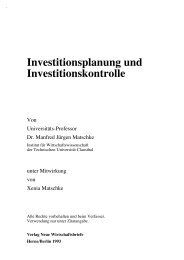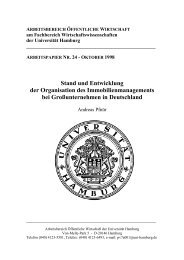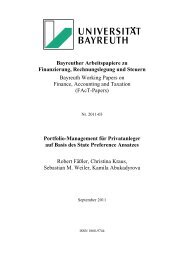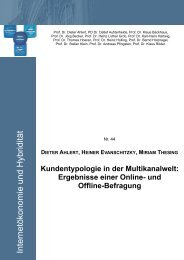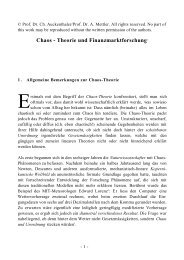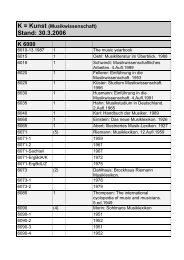FRANCE The
FRANCE The
FRANCE The
You also want an ePaper? Increase the reach of your titles
YUMPU automatically turns print PDFs into web optimized ePapers that Google loves.
Trends<br />
focused on this issue. According to DARES, it is mainly in the<br />
industry, building, finance and property sectors that thinking, if not<br />
action, is going on with regard to the issue of older workers and,<br />
within these sectors, only in large establishments with an ageing<br />
personnel which have undergone some technical or organisational<br />
upheaval. In these establishments, measures to encourage careerend<br />
part-time working are emerging, together with, in an as yet very<br />
marginal way, a genuine Human Resources policy in respect of older<br />
employees, such as the agreement on the “valorisation of experience<br />
and career-ends” signed in late 2001 at THALES, systematically<br />
introducing a career evaluation at age 45, which may lead to an<br />
entitlement to one hundred and twenty hours of training.<br />
Increasingly, the occupational sub-sector bodies most affected by<br />
the ageing of the population are attempting progressively to modify<br />
the behaviour of their members in terms of age management. In an<br />
agreement of January 2001, the French Banking Association<br />
(Association Française des Banques or AFB) called on its members<br />
to avoid any early retirement before the age of 58, whereas<br />
employees could previously expect to benefit from such<br />
arrangements from the age of 50. Nevertheless, alongside these<br />
good practices, the introduction of time-savings accounts within<br />
companies, which allows employees to “save up” the hours worked<br />
in excess of the thirty-five hour week and deduct these from their<br />
working life, is a measure directed toward shortening working life<br />
rather than extending it.<br />
Conclusions<br />
In this way, the current political framework and the actual practices<br />
met with in companies send out relatively contradictory messages.<br />
At any rate, those messages are not sufficiently clear to bring about a<br />
marked change in behaviour or create a different attitude to workers<br />
aged over 50. This is, admittedly, a delicate subject, since there is a<br />
strong social consensus in this area: “in the 1980s, early retirement<br />
was experienced as redundancy, whereas it is now claimed as an<br />
established right.” <strong>The</strong> reform of the pensions system will probably<br />
be crucial, then, in the future development of activity rates of older<br />
workers, but we may nonetheless regret that it is not accompanied by<br />
parallel messages aimed at shifting public opinion on this subject in<br />
a more positive direction than the mere question of the funding of<br />
pensions. This is an issue that will play a major role in our future<br />
development.<br />
Sandrine Gineste<br />
Bibliography<br />
INSEE, “Projections de population active: un retournement<br />
progressif” (Collection INSEE Premières), March 2002.<br />
– “Enquête sur l’emploi de mars 2002” (Collection INSEE<br />
Premières), July 2002.<br />
– “La population de la France métropolitaine en 2050: un<br />
vieillissement inéluctable”, Economie et Statistiques, December<br />
2002.<br />
– “Projections de population active en 2050: l’essoufflement de la<br />
croissance de ressources en main d’œuvre”, ibid.<br />
DARES, “Moins de préretraites en 2001”, Premières informations,<br />
premières syntheses, January 2003;<br />
– “Les préretraites: un outil important de gestion des âges”, ibid.,<br />
November 2002;<br />
– “les entreprises se préoccupent peu du vieillissement<br />
démographique”, ibid., April 2002 ;<br />
– “le papy-boom renforce l’activité des seniors”, ibid., April 2002;<br />
– “l’âge des salariés joue surtout à l’embauche”, ibid.;<br />
– “bilan des préretraites et des mesures en faveur des chômeurs<br />
ages”, ibid., January 2002;<br />
– “les quinquagénaires entre l’activité et la retraite”, ibid., October<br />
2001.<br />
All the above articles are available on line on the website of the<br />
French Ministry of Social Affairs.<br />
OFCE, France, “2000-2040: population active et croissance”.<br />
Caisse Nationale d’assurance Maladie, Retraite et société, issues 36<br />
et 37.<br />
Conseil Economique et Social, Dynamique de la population active et<br />
emploi : la gestion prévisionnelle des âges, Paris, 2000. This<br />
document, known as the Quintreau Report, is available on line at the<br />
CES website.<br />
Chambre de commerce et d’industrie de Paris, commission du<br />
travail et des questions sociales, Rapport pour la suppression de la<br />
contribution Delalande,Paris, 2001.<br />
Commissariat Général du Plan, Avenir des métiers, rapport du groupe<br />
“prospective des métiers et des qualifications”, Paris, November<br />
2002. Available on-line at the CGP site.<br />
Journées d’étude du CEREQ, La mobilité professionnelle des salariés<br />
âgés analysée à travers les DADS,May 2002.<br />
Conseil d’analyse économique, Reports and letters.<br />
Lettres de l’Observatoire des Retraites (bi-annual newsletters).<br />
84 Spring 2003 | European Employment Observatory Review



